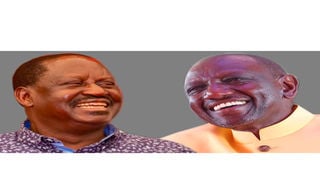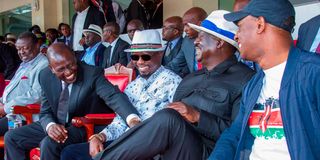
Opposition leader Raila Odinga (left) and President William Ruto.
| Nation Media GroupPolitics
Premium
Birds of a feather: Raila, Ruto rev up for rematch in 2027
What you need to know:
- The two former allies-turned-foes are assembling their campaign machineries on the road to the next elections.
- Along their political journey, the two have wooed new allies, dumped some and re-united with others.
President William Ruto and opposition leader Raila Odinga are revving up their campaign vehicles, their parties scheduling grassroots elections next month and early next year, respectively, as jostling for the 2027 general election gets underway.
Yesterday, Mr Odinga launched Orange Democratic Alliance (ODM) mass membership registration in Siaya, following in the footsteps of the President’s United Democratic Alliance (UDA), which says it is building on its 7.2 million registered member-base ahead of December 9 party polls, as the two bitter rivals in last year’s presidential vote prepare for a possible rematch in 2027.
The two former allies-turned-foes are assembling their campaign machineries on the road to the next elections that is already seeing realignments rekindling the political journey the duo has walked over the years. Their roads crossed in 2007 when they fought from the same camp, before parting ways as Dr Ruto charted a new path that led him to State House last year.
Along their political journey, the two have wooed new allies, dumped some and re-united with others. Their latest friction point was the grievance that the President poached some of Mr Odinga’s allies, particularly from his Nyanza bedrock.
It is one of the contentious issues under arbitration by the mediation teams that represented them in negotiating a settlement of the disputed 2022 presidential election that escalated in bloody anti-government riots this year.
Analysts suggest that the talks over which the dialogue team has retreated to compile a report for the two principals and Parliament for enactment, are designed to politically benefit the two ahead of the 2027 polls.
A potential dialogue frowned upon by some senior figures in the ruling Kenya Kwanza coalition who feel it could extend political capital to Mr Odinga at their expense, is yet another platform to advance the two leaders’ political careers spanning decades but dotted with bitter falling out, betrayals and switching of political parties and coalitions every electoral cycle.
The two seem to have cut links with nearly all their senior political allies and mentors, lending credence to their aggressive and ambitious style of leadership and pursuit for personal interests.
Politicians who have worked with the duo point out that the two have huge egos and are always willing to sever links with their allies anytime their interests are threatened.
President Ruto, for instance, fell out with most of veteran politicians he worked with in the past, from his predecessors Daniel arap Moi and Uhuru Kenyatta, Mr Odinga and a host of veteran politicians from the larger Rift Valley.
In his Rift Valley backyard, a coterie of youthful politicians has emerged, sweeping away former powerful individuals created by the Kanu regime. Former Cabinet Ministers like Sally Kosgei, Henry Kosgei, Franklin Bett and former Baringo Senator and Kanu boss have all been pushed to the back banner of the region’s politics.
From governors, MPs and MCAs, Rift Valley has a majority of young elected leaders compared with other regions in the country.
Dr Ruto has also ended up in a bitter falling out with his party leaders, before switching camps to either form a party or enter into a coalition with new allies.
In the run-up to last year’s polls, he fell out with his former boss at Jubilee Party, Mr Kenyatta. He subsequently formed UDA and proceeded to win the presidency.
Previously, Dr Ruto was in a similar falling out with Mr Odinga and was expelled from the party before teaming up with Mr Kenyatta in the run-up to 2013 polls through The National Alliance (TNA) and United Republican Party (URP) partnership.
President Ruto, who has in some quarters been described as a creation of the Youth For Kanu (YK '92) outfit, had a similar falling out with then President Moi.
He was among the students who headed University of Nairobi Kanu sub-branches and would occasionally organise trips to State House or Karbanet Gardens.
He would in 1997 surprisingly beat incumbent Eldoret North MP, Reuben Chesire and proceeded to gain favour with the late Moi. He remained in Moi’s corner in backing Mr Kenyatta’s first attempt at the presidency in 2002.
But he later fell out with Moi. In a previous interview, Dr Ruto revealed that it was after his declaration to run for the country’s top seat during a rally in Eldama Ravine in 2005 that the relationship between him and the former head of state took a different turn.
“In Eldama Ravine where I declared my candidature for the presidency was the straw that broke the camel’s back,” said Ruto.

President William Ruto and Azimio leader Raila Odinga at Kipkeino Classic at Moi Sports Center Kasarani on May 13, 2023.
“From Eldama Ravine I thought it was a simple thing. We were around 15 MPs, and it was customary that whenever we were around Nakuru, we would visit Mzee, have a cup of tea and a little chat before heading back. This time around we found the gate closed. We were told Mzee doesn’t want to see us,” he said.
Mr Bett described the relationship of Moi and Ruto as that of a father and over-ambitious son. “Politics is a game of egos and an aspect of self-centeredness. It is in all politicians and I cannot blame anyone for falling out with those they have worked with. It is all about interests. Don’t be surprised if Ruto and Raila work together again,” he said.
Jubilee Vice chairman David Murathe says some of the unions were marriages of convenience.
“Some of those coalitions were marriages of convenience. Those people (Uhuru and Ruto) are different in terms of philosophy. For instance, right now Ruto is trying to amend the constitution to create positions he opposed during the BBI,” Mr Murathe said.
Mr Odinga has also severed links with many of his former allies. The former Prime Minister had a troubled political relationship with the late Mwai Kibaki, Mr Moi and former Vice President Kijana Wawalwa during their time at Ford Kenya.
This despite his famous “Kibaki Tosha” playing a big role in propelling Kibaki to presidency.
Mr Kibaki won the December 27, 2002, general election with a landslide, beating Moi’s candidate, Mr Kenyatta.
But internal wrangles ensued following a failed power-sharing pact. Mr Odinga’s personal ambition worsened the situation.
Mr Odinga would later accuse Mr Kibaki of refusing to honour a pre-election MOU that involved changing the constitution to make him Prime Minister.
The 2005 referendum where Mr Odinga teamed up with other leaders to defeat the draft constitution backed by Mr Kibaki became Narc’s waterloo.
Mr Kibaki responded by firing Mr Odinga from the Cabinet alongside his allies. They would ride on the referendum win to challenge Mr Kibaki in the 2007 presidential race.
Mr Odinga disputed the outcome leading to a post-election crisis that forced the formation of the Grand Coalition Government where Mr Odinga served as a Prime Minister.
Political analyst Prof Macharia Munene says both Mr Odinga and the President are ambitious and aggressive. He, however, notes that Mr Odinga is not as strategic as Dr Ruto.

President William Ruto shakes hands with former Prime Minister Raila Odinga on Saturday, May 13, 2023.
“Ruto is a student Raila and Moi combined. Raila is desperate to become President. If anyone tries to block his path, he does away with them,” says Prof Macharia.
At Ford Kenya, Mr Odinga was embroiled in a leadership tussle with the late Wamalwa, who had succeeded Jaramogi at the helm.
Mr Odinga would in 1997 lead his supporters in ditching the party after he lost the leadership battle to Mr Wamalwa. He formed the National Development Party (NDP) and ran for the first time for presidency, emerging third after Moi and Kibaki.





